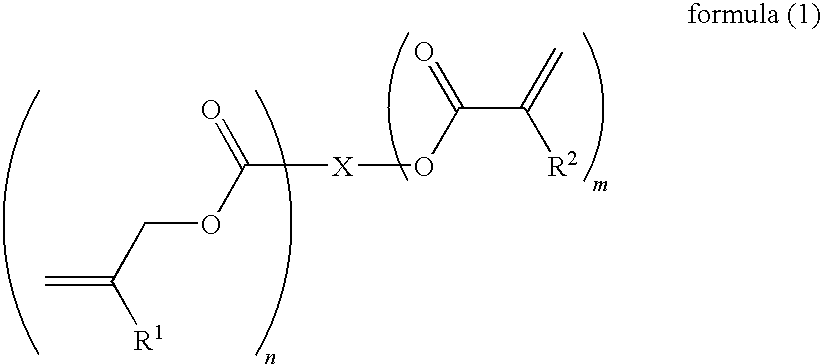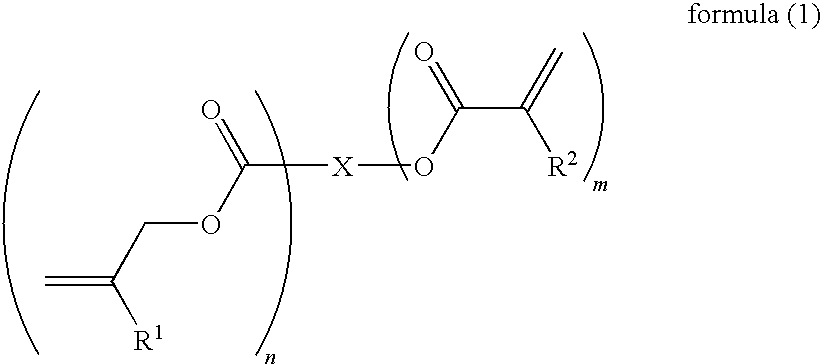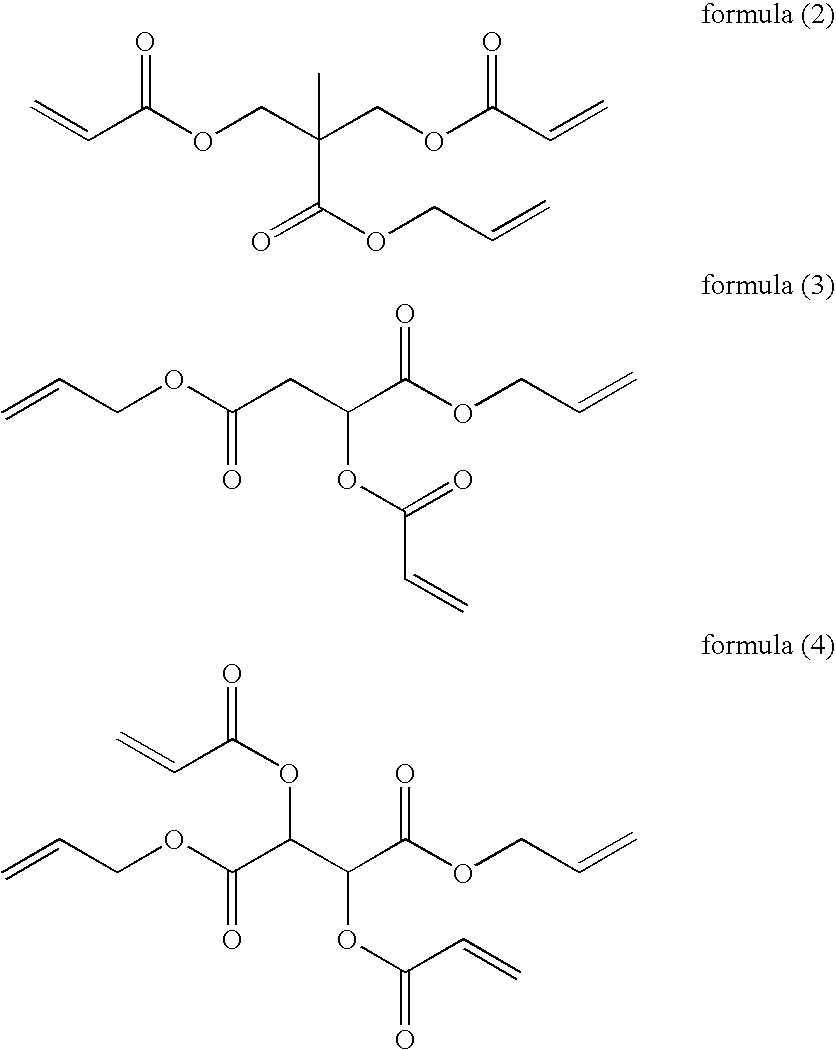Curable composition for photoimprint, its cured product and production method for it, and component of liquid-crystal display device
a technology of liquid crystal display device and composition, which is applied in the direction of photomechanical equipment, electric/magnetic/electromagnetic heating, instruments, etc., to achieve the effects of high transfer patterning accuracy, excellent scratch resistance and adhesiveness of formed films, and low viscosity
- Summary
- Abstract
- Description
- Claims
- Application Information
AI Technical Summary
Benefits of technology
Problems solved by technology
Method used
Image
Examples
production example 1
Production of AL-1
[0142]2,2-Bis(hydroxymethyl)propionic acid (by Tokyo Chemical) (20.0 g) was dissolved in N-methylpyrrolidinone (NMP) (150 ml), and sodium hydrogencarbonate (by Wako Pure Chemical) (13.8 g) was added thereto, and then allyl bromide (by Tokyo Chemical) (19.8 g) was added thereto. This was heated up to an inner temperature of 80° C., then stirred for 8 hours, and thereafter left cooled. When the inner temperature reached lower than 35° C., NMP (50 ml) was added to it, and then 3-chloropropionyl chloride (by Tokyo Chemical) (60.6 g) was dropwise thereto. This was kept at an inner temperature of 50° C. and stirred for 2 hours, and then left cooled. When the inner temperature reached lower than 35° C., an aqueous solution of saturated sodium hydrogencarbonate (400 ml) was dropwise added to it, then ethyl acetate (400 ml) was added thereto and processed for liquid-liquid separation. The organic layer was washed with an aqueous solution of 0.2 N hydrochloric acid (250 ml)....
production example 2
Production of AL-2
[0147]In the same manner as that for AL-1 but starting from DL-malic acid (by Tokyo Chemical) (80.0 g), a crude product of AL-2 was produced. The crude product was purified through silica gel column chromatography to give AL-2 (96.2 g) (three-step yield, 60%).
[0148]1H NMR and the viscosity data with an E-type viscometer of the obtained AL-2 are shown below.
[0149]1H NMR (300 MHz, CDCl3) δ 6.5 (d, 1H), δ 6.2 (dd, 1H), δ 6.0-5.8 (m, 3H), δ 5.6 (d, 1H), δ 5.4-5.2 (m, 4H), δ 4.7 (d, 2H), δ 4.6 (d, 2H)
Viscosity 13.9 mPa·s (25° C.)
Molecular weight 268.26
production example 3
Production of AL-3
[0150]In the same manner as that for AL-1 but starting from DL-tartaric acid (by Tokyo Chemical) (20.0 g), a crude product of AL-3 was produced. The crude product was purified through silica gel column chromatography to give AL-3 (32.5 g) (three-step yield, 72%).
[0151]1H NMR and the viscosity data with an E-type viscometer of the obtained AL-3 are shown below.
[0152]1H NMR (300 MHz, CDCl3) δ 6.5 (d, 2H), δ 6.2 (dd, 2H), δ 6.0 (d, 2H), δ 5.9-5.7 (m, 4H), δ 5.3 (d, 4H), 5.2 (d, 4H), δ 4.8-4.6 (m, 4H)
Viscosity 76.9 mPa·s (25° C.)
Molecular weight 338.31
PUM
| Property | Measurement | Unit |
|---|---|---|
| Temperature | aaaaa | aaaaa |
| Viscosity | aaaaa | aaaaa |
| Composition | aaaaa | aaaaa |
Abstract
Description
Claims
Application Information
 Login to View More
Login to View More - R&D
- Intellectual Property
- Life Sciences
- Materials
- Tech Scout
- Unparalleled Data Quality
- Higher Quality Content
- 60% Fewer Hallucinations
Browse by: Latest US Patents, China's latest patents, Technical Efficacy Thesaurus, Application Domain, Technology Topic, Popular Technical Reports.
© 2025 PatSnap. All rights reserved.Legal|Privacy policy|Modern Slavery Act Transparency Statement|Sitemap|About US| Contact US: help@patsnap.com



